Complete Business Solutions: Workforce Planning Management Report
VerifiedAdded on 2022/08/13
|15
|2812
|9
Report
AI Summary
This report provides a comprehensive analysis of workforce planning for Complete Business Solutions, Australia. It begins by monitoring external labor trends, including demographic changes, globalization, and increasing female participation, and their impact on labor demand and supply. The report then details the development of employee satisfaction surveys to gauge employee opinions on company culture, career opportunities, productivity, and teamwork. Following this, it determines workforce requirements by analyzing staff turnover and demographics, identifying issues such as low pay, high workloads, and lack of growth opportunities, and proposing solutions like health benefits and recognition programs. The report presents a workforce plan with strategic objectives and performance measurements, along with a contingency plan addressing business risks such as inadequate time and high costs. Finally, it outlines the stages of workforce planning, including information collation, profile revision, action plan implementation, and monitoring, and discusses the implementation strategy through meetings and conferences. The assignment concludes with a discussion on the use of checklists and templates to support the workforce planning process.
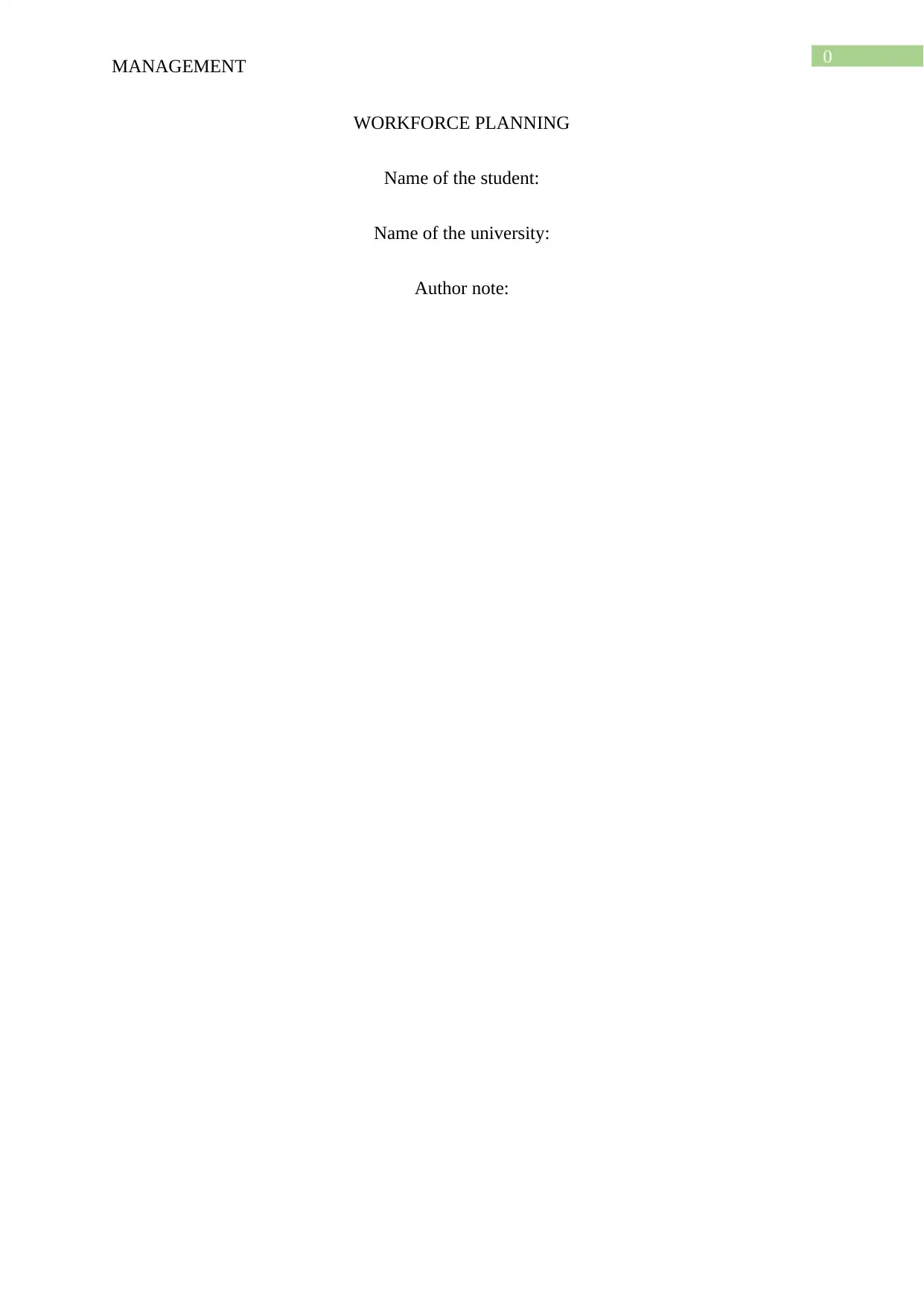
0
MANAGEMENT
WORKFORCE PLANNING
Name of the student:
Name of the university:
Author note:
MANAGEMENT
WORKFORCE PLANNING
Name of the student:
Name of the university:
Author note:
Paraphrase This Document
Need a fresh take? Get an instant paraphrase of this document with our AI Paraphraser
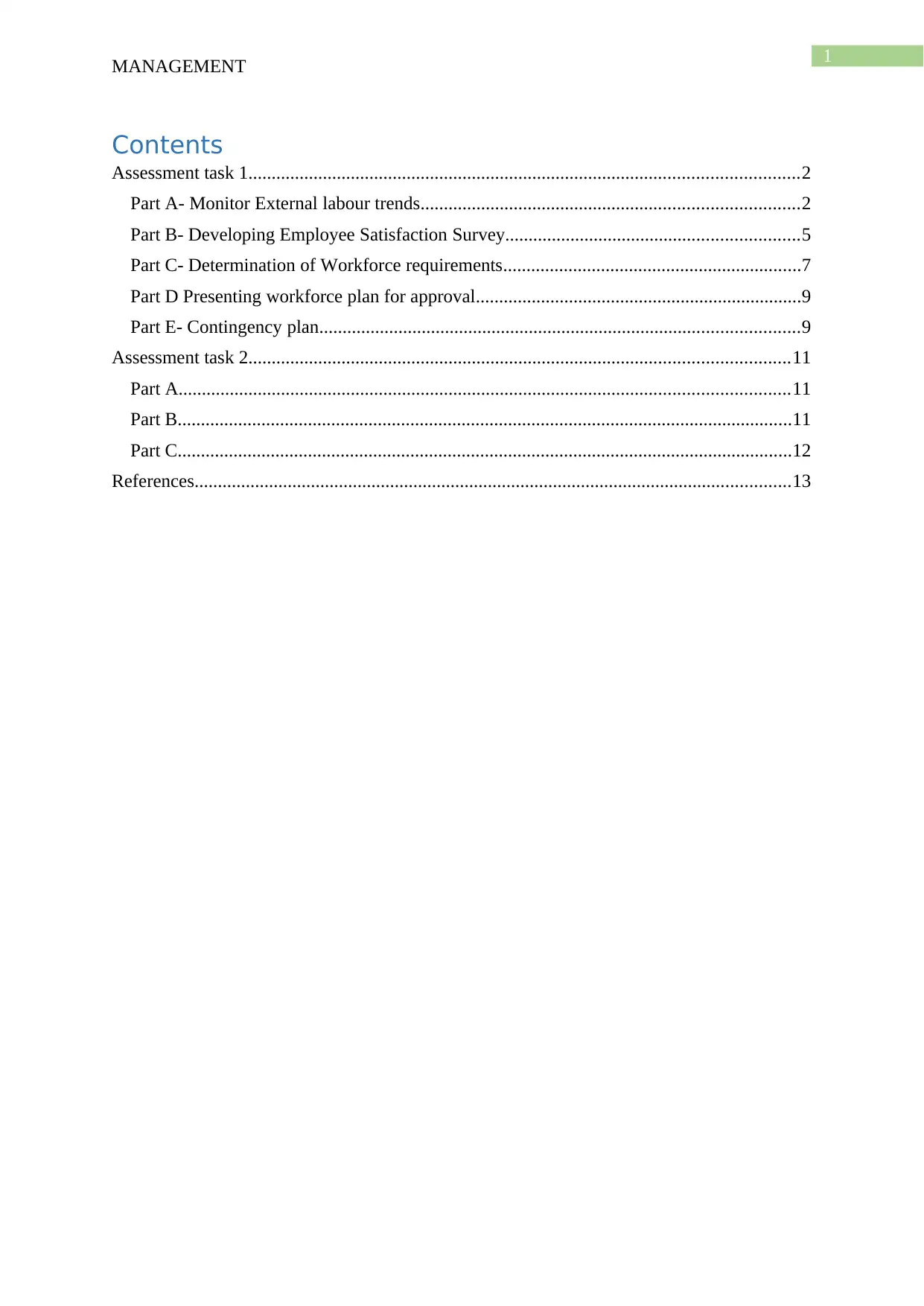
1
MANAGEMENT
Contents
Assessment task 1......................................................................................................................2
Part A- Monitor External labour trends.................................................................................2
Part B- Developing Employee Satisfaction Survey...............................................................5
Part C- Determination of Workforce requirements................................................................7
Part D Presenting workforce plan for approval......................................................................9
Part E- Contingency plan.......................................................................................................9
Assessment task 2....................................................................................................................11
Part A...................................................................................................................................11
Part B....................................................................................................................................11
Part C....................................................................................................................................12
References................................................................................................................................13
MANAGEMENT
Contents
Assessment task 1......................................................................................................................2
Part A- Monitor External labour trends.................................................................................2
Part B- Developing Employee Satisfaction Survey...............................................................5
Part C- Determination of Workforce requirements................................................................7
Part D Presenting workforce plan for approval......................................................................9
Part E- Contingency plan.......................................................................................................9
Assessment task 2....................................................................................................................11
Part A...................................................................................................................................11
Part B....................................................................................................................................11
Part C....................................................................................................................................12
References................................................................................................................................13
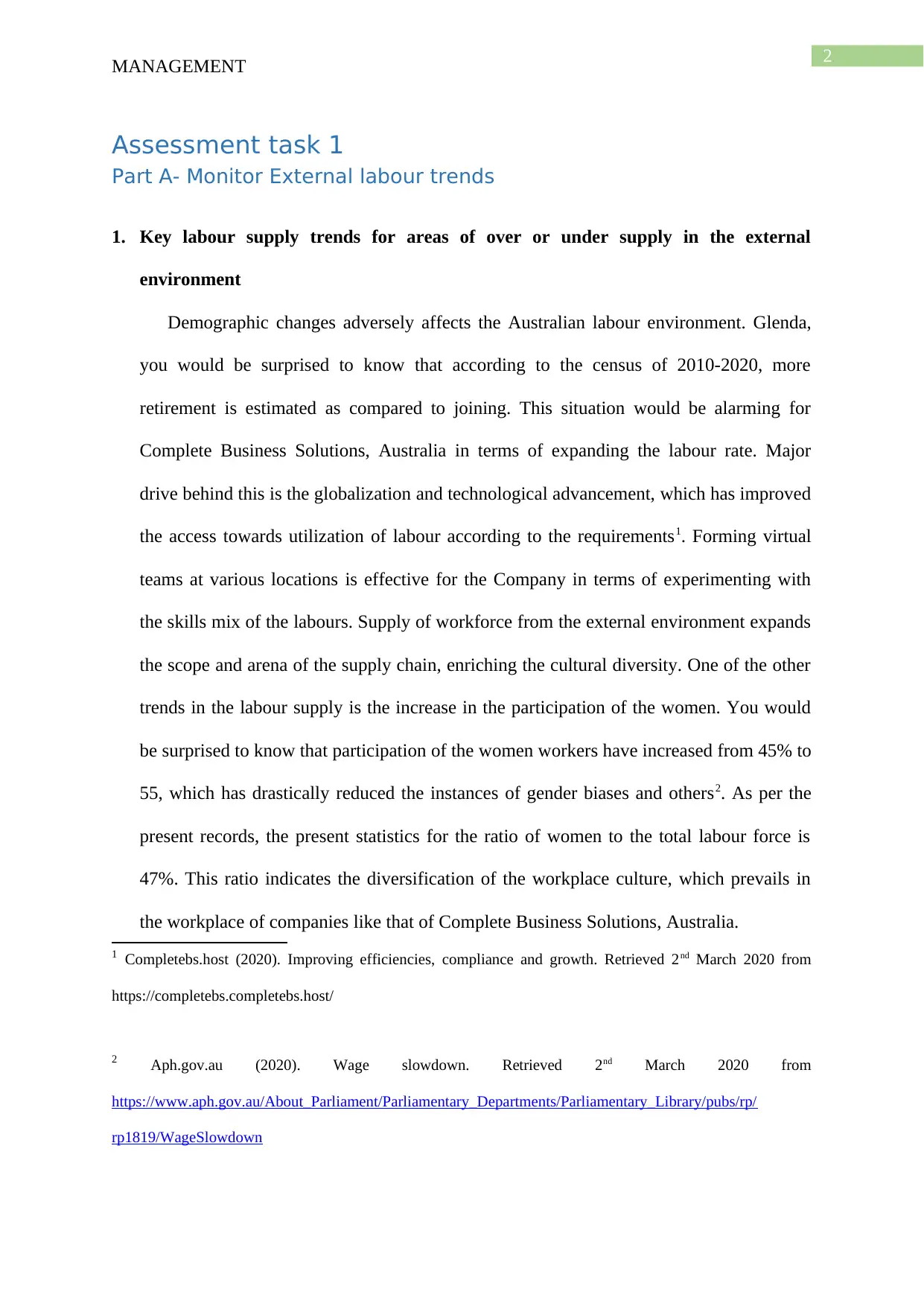
2
MANAGEMENT
Assessment task 1
Part A- Monitor External labour trends
1. Key labour supply trends for areas of over or under supply in the external
environment
Demographic changes adversely affects the Australian labour environment. Glenda,
you would be surprised to know that according to the census of 2010-2020, more
retirement is estimated as compared to joining. This situation would be alarming for
Complete Business Solutions, Australia in terms of expanding the labour rate. Major
drive behind this is the globalization and technological advancement, which has improved
the access towards utilization of labour according to the requirements1. Forming virtual
teams at various locations is effective for the Company in terms of experimenting with
the skills mix of the labours. Supply of workforce from the external environment expands
the scope and arena of the supply chain, enriching the cultural diversity. One of the other
trends in the labour supply is the increase in the participation of the women. You would
be surprised to know that participation of the women workers have increased from 45% to
55, which has drastically reduced the instances of gender biases and others2. As per the
present records, the present statistics for the ratio of women to the total labour force is
47%. This ratio indicates the diversification of the workplace culture, which prevails in
the workplace of companies like that of Complete Business Solutions, Australia.
1 Completebs.host (2020). Improving efficiencies, compliance and growth. Retrieved 2nd March 2020 from
https://completebs.completebs.host/
2 Aph.gov.au (2020). Wage slowdown. Retrieved 2nd March 2020 from
https://www.aph.gov.au/About_Parliament/Parliamentary_Departments/Parliamentary_Library/pubs/rp/
rp1819/WageSlowdown
MANAGEMENT
Assessment task 1
Part A- Monitor External labour trends
1. Key labour supply trends for areas of over or under supply in the external
environment
Demographic changes adversely affects the Australian labour environment. Glenda,
you would be surprised to know that according to the census of 2010-2020, more
retirement is estimated as compared to joining. This situation would be alarming for
Complete Business Solutions, Australia in terms of expanding the labour rate. Major
drive behind this is the globalization and technological advancement, which has improved
the access towards utilization of labour according to the requirements1. Forming virtual
teams at various locations is effective for the Company in terms of experimenting with
the skills mix of the labours. Supply of workforce from the external environment expands
the scope and arena of the supply chain, enriching the cultural diversity. One of the other
trends in the labour supply is the increase in the participation of the women. You would
be surprised to know that participation of the women workers have increased from 45% to
55, which has drastically reduced the instances of gender biases and others2. As per the
present records, the present statistics for the ratio of women to the total labour force is
47%. This ratio indicates the diversification of the workplace culture, which prevails in
the workplace of companies like that of Complete Business Solutions, Australia.
1 Completebs.host (2020). Improving efficiencies, compliance and growth. Retrieved 2nd March 2020 from
https://completebs.completebs.host/
2 Aph.gov.au (2020). Wage slowdown. Retrieved 2nd March 2020 from
https://www.aph.gov.au/About_Parliament/Parliamentary_Departments/Parliamentary_Library/pubs/rp/
rp1819/WageSlowdown
⊘ This is a preview!⊘
Do you want full access?
Subscribe today to unlock all pages.

Trusted by 1+ million students worldwide
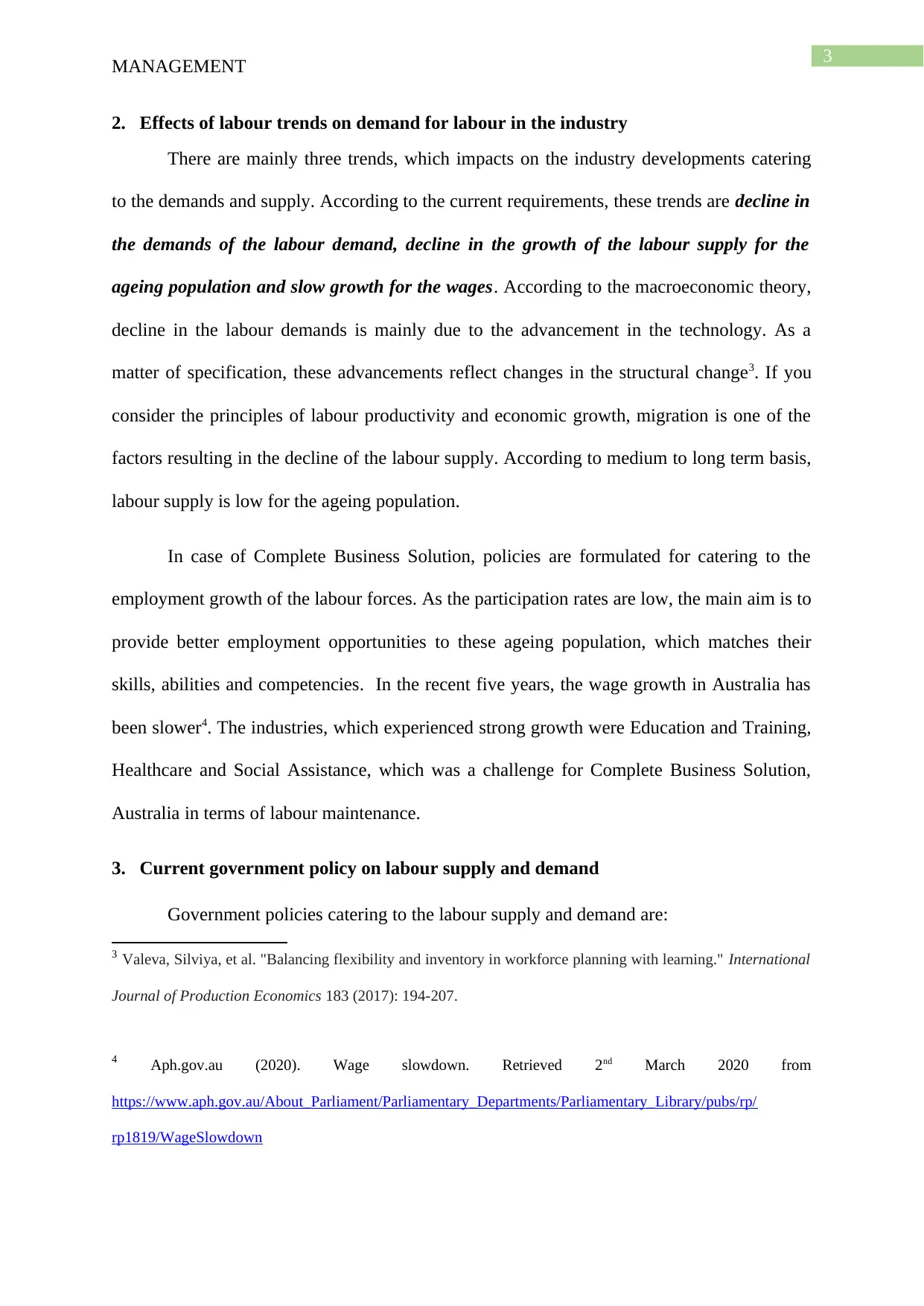
3
MANAGEMENT
2. Effects of labour trends on demand for labour in the industry
There are mainly three trends, which impacts on the industry developments catering
to the demands and supply. According to the current requirements, these trends are decline in
the demands of the labour demand, decline in the growth of the labour supply for the
ageing population and slow growth for the wages. According to the macroeconomic theory,
decline in the labour demands is mainly due to the advancement in the technology. As a
matter of specification, these advancements reflect changes in the structural change3. If you
consider the principles of labour productivity and economic growth, migration is one of the
factors resulting in the decline of the labour supply. According to medium to long term basis,
labour supply is low for the ageing population.
In case of Complete Business Solution, policies are formulated for catering to the
employment growth of the labour forces. As the participation rates are low, the main aim is to
provide better employment opportunities to these ageing population, which matches their
skills, abilities and competencies. In the recent five years, the wage growth in Australia has
been slower4. The industries, which experienced strong growth were Education and Training,
Healthcare and Social Assistance, which was a challenge for Complete Business Solution,
Australia in terms of labour maintenance.
3. Current government policy on labour supply and demand
Government policies catering to the labour supply and demand are:
3 Valeva, Silviya, et al. "Balancing flexibility and inventory in workforce planning with learning." International
Journal of Production Economics 183 (2017): 194-207.
4 Aph.gov.au (2020). Wage slowdown. Retrieved 2nd March 2020 from
https://www.aph.gov.au/About_Parliament/Parliamentary_Departments/Parliamentary_Library/pubs/rp/
rp1819/WageSlowdown
MANAGEMENT
2. Effects of labour trends on demand for labour in the industry
There are mainly three trends, which impacts on the industry developments catering
to the demands and supply. According to the current requirements, these trends are decline in
the demands of the labour demand, decline in the growth of the labour supply for the
ageing population and slow growth for the wages. According to the macroeconomic theory,
decline in the labour demands is mainly due to the advancement in the technology. As a
matter of specification, these advancements reflect changes in the structural change3. If you
consider the principles of labour productivity and economic growth, migration is one of the
factors resulting in the decline of the labour supply. According to medium to long term basis,
labour supply is low for the ageing population.
In case of Complete Business Solution, policies are formulated for catering to the
employment growth of the labour forces. As the participation rates are low, the main aim is to
provide better employment opportunities to these ageing population, which matches their
skills, abilities and competencies. In the recent five years, the wage growth in Australia has
been slower4. The industries, which experienced strong growth were Education and Training,
Healthcare and Social Assistance, which was a challenge for Complete Business Solution,
Australia in terms of labour maintenance.
3. Current government policy on labour supply and demand
Government policies catering to the labour supply and demand are:
3 Valeva, Silviya, et al. "Balancing flexibility and inventory in workforce planning with learning." International
Journal of Production Economics 183 (2017): 194-207.
4 Aph.gov.au (2020). Wage slowdown. Retrieved 2nd March 2020 from
https://www.aph.gov.au/About_Parliament/Parliamentary_Departments/Parliamentary_Library/pubs/rp/
rp1819/WageSlowdown
Paraphrase This Document
Need a fresh take? Get an instant paraphrase of this document with our AI Paraphraser
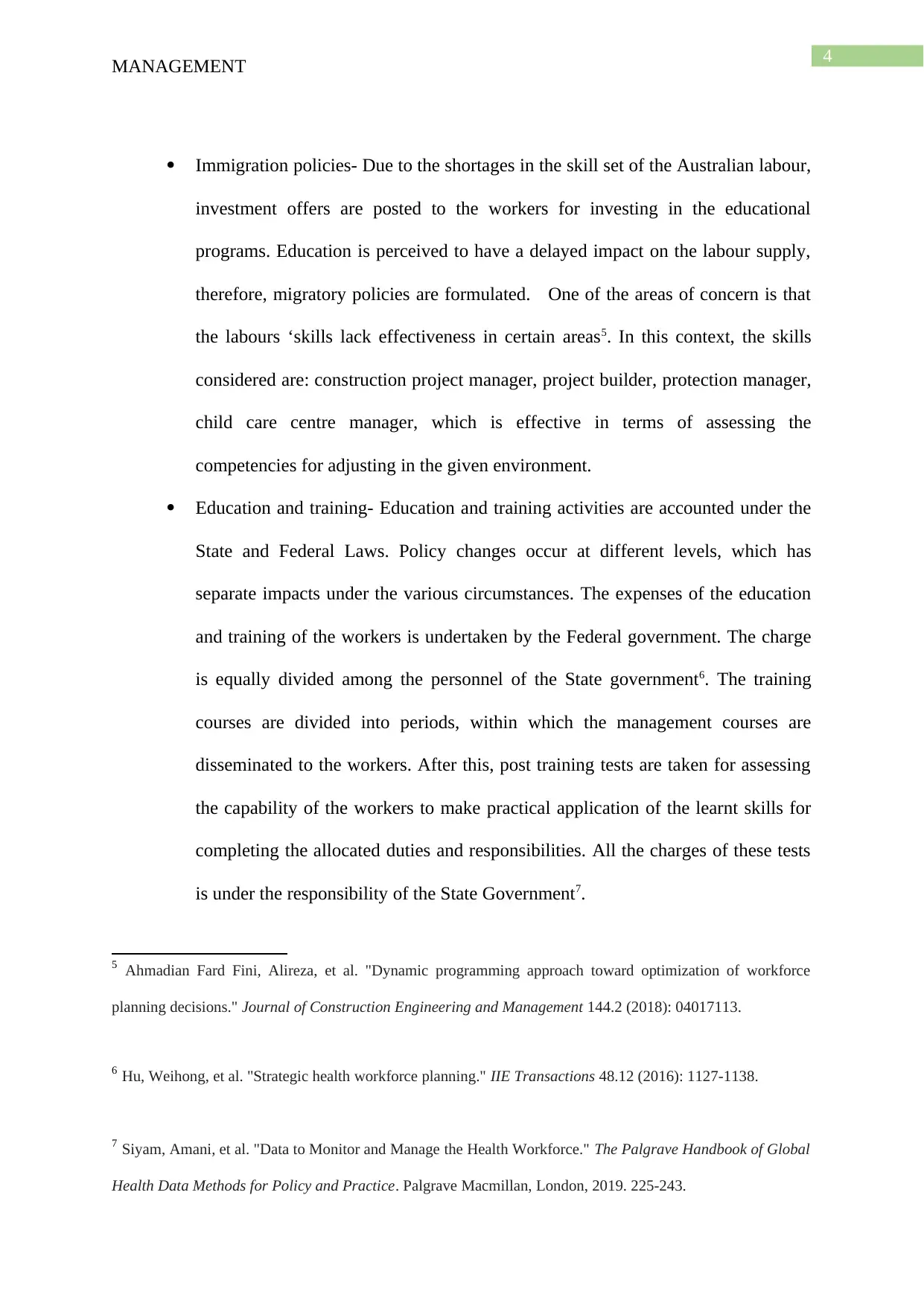
4
MANAGEMENT
Immigration policies- Due to the shortages in the skill set of the Australian labour,
investment offers are posted to the workers for investing in the educational
programs. Education is perceived to have a delayed impact on the labour supply,
therefore, migratory policies are formulated. One of the areas of concern is that
the labours ‘skills lack effectiveness in certain areas5. In this context, the skills
considered are: construction project manager, project builder, protection manager,
child care centre manager, which is effective in terms of assessing the
competencies for adjusting in the given environment.
Education and training- Education and training activities are accounted under the
State and Federal Laws. Policy changes occur at different levels, which has
separate impacts under the various circumstances. The expenses of the education
and training of the workers is undertaken by the Federal government. The charge
is equally divided among the personnel of the State government6. The training
courses are divided into periods, within which the management courses are
disseminated to the workers. After this, post training tests are taken for assessing
the capability of the workers to make practical application of the learnt skills for
completing the allocated duties and responsibilities. All the charges of these tests
is under the responsibility of the State Government7.
5 Ahmadian Fard Fini, Alireza, et al. "Dynamic programming approach toward optimization of workforce
planning decisions." Journal of Construction Engineering and Management 144.2 (2018): 04017113.
6 Hu, Weihong, et al. "Strategic health workforce planning." IIE Transactions 48.12 (2016): 1127-1138.
7 Siyam, Amani, et al. "Data to Monitor and Manage the Health Workforce." The Palgrave Handbook of Global
Health Data Methods for Policy and Practice. Palgrave Macmillan, London, 2019. 225-243.
MANAGEMENT
Immigration policies- Due to the shortages in the skill set of the Australian labour,
investment offers are posted to the workers for investing in the educational
programs. Education is perceived to have a delayed impact on the labour supply,
therefore, migratory policies are formulated. One of the areas of concern is that
the labours ‘skills lack effectiveness in certain areas5. In this context, the skills
considered are: construction project manager, project builder, protection manager,
child care centre manager, which is effective in terms of assessing the
competencies for adjusting in the given environment.
Education and training- Education and training activities are accounted under the
State and Federal Laws. Policy changes occur at different levels, which has
separate impacts under the various circumstances. The expenses of the education
and training of the workers is undertaken by the Federal government. The charge
is equally divided among the personnel of the State government6. The training
courses are divided into periods, within which the management courses are
disseminated to the workers. After this, post training tests are taken for assessing
the capability of the workers to make practical application of the learnt skills for
completing the allocated duties and responsibilities. All the charges of these tests
is under the responsibility of the State Government7.
5 Ahmadian Fard Fini, Alireza, et al. "Dynamic programming approach toward optimization of workforce
planning decisions." Journal of Construction Engineering and Management 144.2 (2018): 04017113.
6 Hu, Weihong, et al. "Strategic health workforce planning." IIE Transactions 48.12 (2016): 1127-1138.
7 Siyam, Amani, et al. "Data to Monitor and Manage the Health Workforce." The Palgrave Handbook of Global
Health Data Methods for Policy and Practice. Palgrave Macmillan, London, 2019. 225-243.
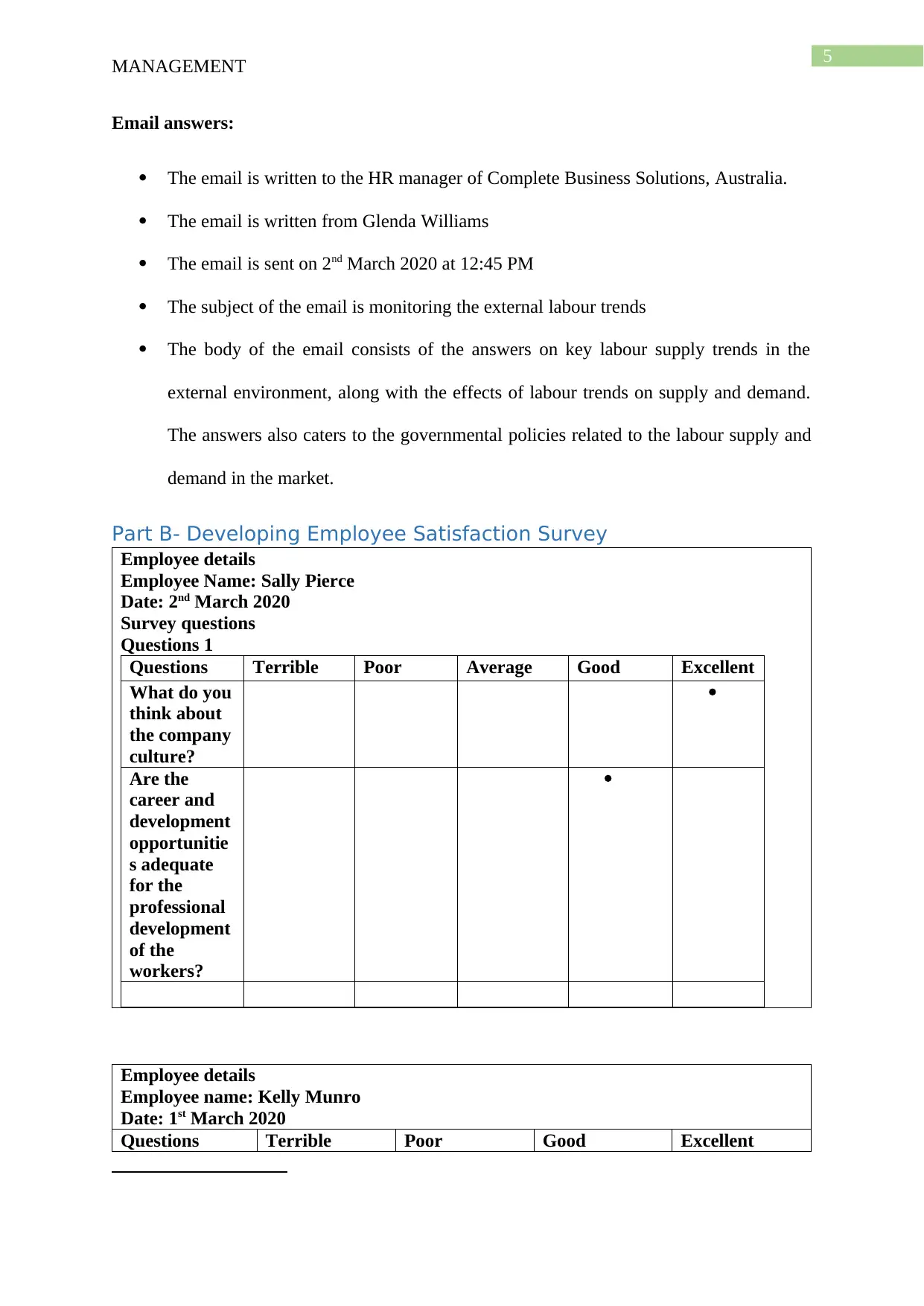
5
MANAGEMENT
Email answers:
The email is written to the HR manager of Complete Business Solutions, Australia.
The email is written from Glenda Williams
The email is sent on 2nd March 2020 at 12:45 PM
The subject of the email is monitoring the external labour trends
The body of the email consists of the answers on key labour supply trends in the
external environment, along with the effects of labour trends on supply and demand.
The answers also caters to the governmental policies related to the labour supply and
demand in the market.
Part B- Developing Employee Satisfaction Survey
Employee details
Employee Name: Sally Pierce
Date: 2nd March 2020
Survey questions
Questions 1
Questions Terrible Poor Average Good Excellent
What do you
think about
the company
culture?
Are the
career and
development
opportunitie
s adequate
for the
professional
development
of the
workers?
Employee details
Employee name: Kelly Munro
Date: 1st March 2020
Questions Terrible Poor Good Excellent
MANAGEMENT
Email answers:
The email is written to the HR manager of Complete Business Solutions, Australia.
The email is written from Glenda Williams
The email is sent on 2nd March 2020 at 12:45 PM
The subject of the email is monitoring the external labour trends
The body of the email consists of the answers on key labour supply trends in the
external environment, along with the effects of labour trends on supply and demand.
The answers also caters to the governmental policies related to the labour supply and
demand in the market.
Part B- Developing Employee Satisfaction Survey
Employee details
Employee Name: Sally Pierce
Date: 2nd March 2020
Survey questions
Questions 1
Questions Terrible Poor Average Good Excellent
What do you
think about
the company
culture?
Are the
career and
development
opportunitie
s adequate
for the
professional
development
of the
workers?
Employee details
Employee name: Kelly Munro
Date: 1st March 2020
Questions Terrible Poor Good Excellent
⊘ This is a preview!⊘
Do you want full access?
Subscribe today to unlock all pages.

Trusted by 1+ million students worldwide
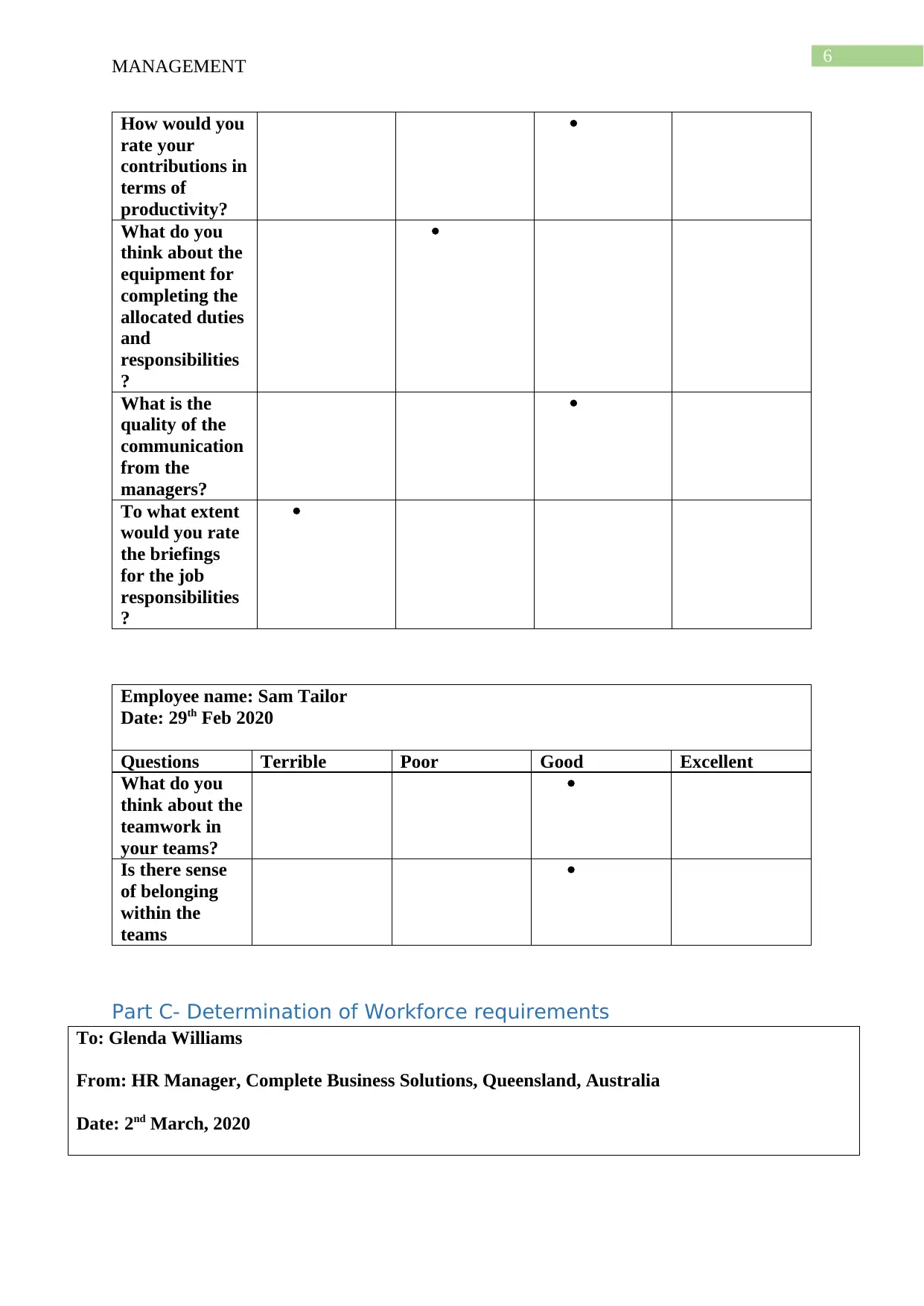
6
MANAGEMENT
How would you
rate your
contributions in
terms of
productivity?
What do you
think about the
equipment for
completing the
allocated duties
and
responsibilities
?
What is the
quality of the
communication
from the
managers?
To what extent
would you rate
the briefings
for the job
responsibilities
?
Employee name: Sam Tailor
Date: 29th Feb 2020
Questions Terrible Poor Good Excellent
What do you
think about the
teamwork in
your teams?
Is there sense
of belonging
within the
teams
Part C- Determination of Workforce requirements
To: Glenda Williams
From: HR Manager, Complete Business Solutions, Queensland, Australia
Date: 2nd March, 2020
MANAGEMENT
How would you
rate your
contributions in
terms of
productivity?
What do you
think about the
equipment for
completing the
allocated duties
and
responsibilities
?
What is the
quality of the
communication
from the
managers?
To what extent
would you rate
the briefings
for the job
responsibilities
?
Employee name: Sam Tailor
Date: 29th Feb 2020
Questions Terrible Poor Good Excellent
What do you
think about the
teamwork in
your teams?
Is there sense
of belonging
within the
teams
Part C- Determination of Workforce requirements
To: Glenda Williams
From: HR Manager, Complete Business Solutions, Queensland, Australia
Date: 2nd March, 2020
Paraphrase This Document
Need a fresh take? Get an instant paraphrase of this document with our AI Paraphraser
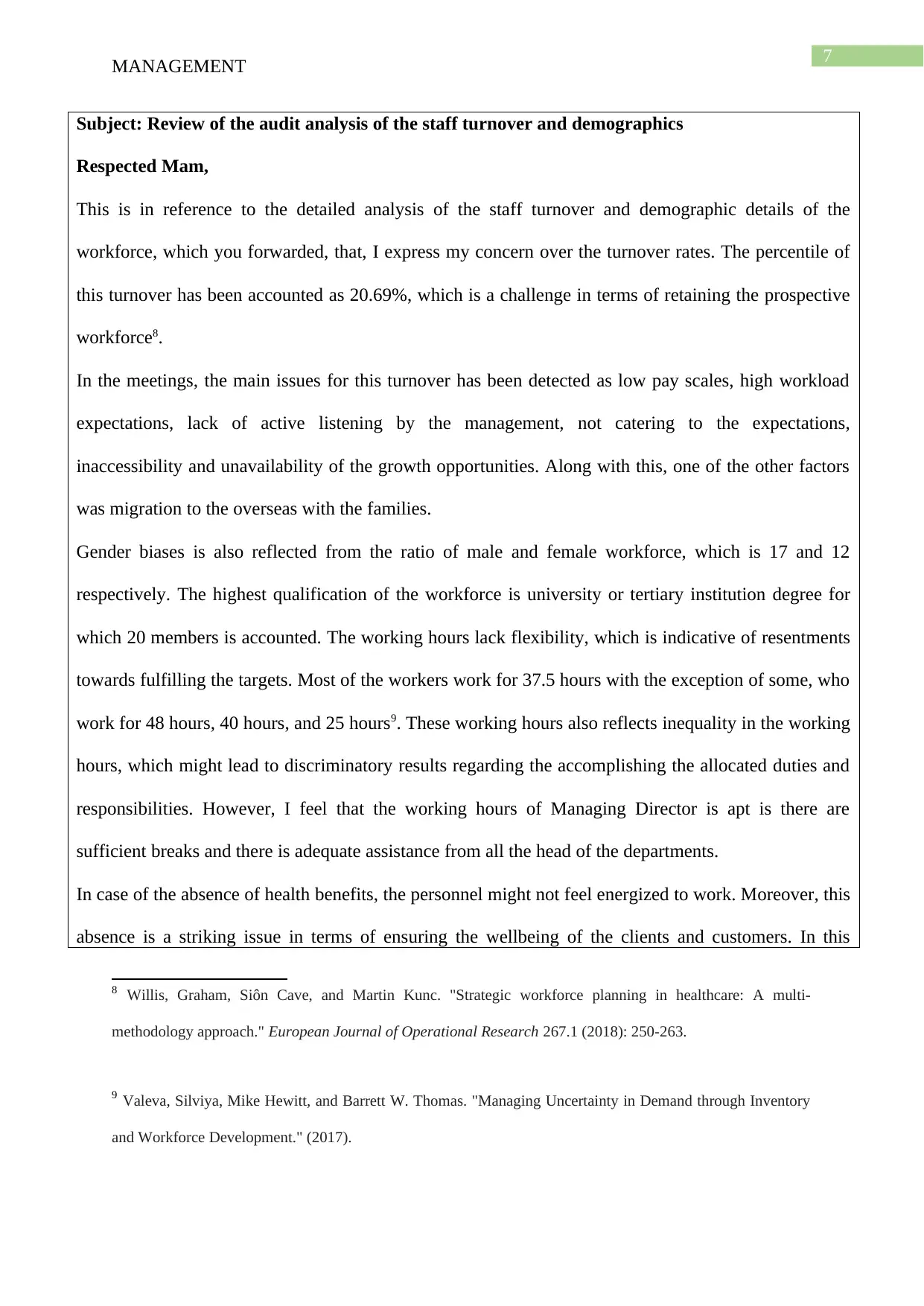
7
MANAGEMENT
Subject: Review of the audit analysis of the staff turnover and demographics
Respected Mam,
This is in reference to the detailed analysis of the staff turnover and demographic details of the
workforce, which you forwarded, that, I express my concern over the turnover rates. The percentile of
this turnover has been accounted as 20.69%, which is a challenge in terms of retaining the prospective
workforce8.
In the meetings, the main issues for this turnover has been detected as low pay scales, high workload
expectations, lack of active listening by the management, not catering to the expectations,
inaccessibility and unavailability of the growth opportunities. Along with this, one of the other factors
was migration to the overseas with the families.
Gender biases is also reflected from the ratio of male and female workforce, which is 17 and 12
respectively. The highest qualification of the workforce is university or tertiary institution degree for
which 20 members is accounted. The working hours lack flexibility, which is indicative of resentments
towards fulfilling the targets. Most of the workers work for 37.5 hours with the exception of some, who
work for 48 hours, 40 hours, and 25 hours9. These working hours also reflects inequality in the working
hours, which might lead to discriminatory results regarding the accomplishing the allocated duties and
responsibilities. However, I feel that the working hours of Managing Director is apt is there are
sufficient breaks and there is adequate assistance from all the head of the departments.
In case of the absence of health benefits, the personnel might not feel energized to work. Moreover, this
absence is a striking issue in terms of ensuring the wellbeing of the clients and customers. In this
8 Willis, Graham, Siôn Cave, and Martin Kunc. "Strategic workforce planning in healthcare: A multi-
methodology approach." European Journal of Operational Research 267.1 (2018): 250-263.
9 Valeva, Silviya, Mike Hewitt, and Barrett W. Thomas. "Managing Uncertainty in Demand through Inventory
and Workforce Development." (2017).
MANAGEMENT
Subject: Review of the audit analysis of the staff turnover and demographics
Respected Mam,
This is in reference to the detailed analysis of the staff turnover and demographic details of the
workforce, which you forwarded, that, I express my concern over the turnover rates. The percentile of
this turnover has been accounted as 20.69%, which is a challenge in terms of retaining the prospective
workforce8.
In the meetings, the main issues for this turnover has been detected as low pay scales, high workload
expectations, lack of active listening by the management, not catering to the expectations,
inaccessibility and unavailability of the growth opportunities. Along with this, one of the other factors
was migration to the overseas with the families.
Gender biases is also reflected from the ratio of male and female workforce, which is 17 and 12
respectively. The highest qualification of the workforce is university or tertiary institution degree for
which 20 members is accounted. The working hours lack flexibility, which is indicative of resentments
towards fulfilling the targets. Most of the workers work for 37.5 hours with the exception of some, who
work for 48 hours, 40 hours, and 25 hours9. These working hours also reflects inequality in the working
hours, which might lead to discriminatory results regarding the accomplishing the allocated duties and
responsibilities. However, I feel that the working hours of Managing Director is apt is there are
sufficient breaks and there is adequate assistance from all the head of the departments.
In case of the absence of health benefits, the personnel might not feel energized to work. Moreover, this
absence is a striking issue in terms of ensuring the wellbeing of the clients and customers. In this
8 Willis, Graham, Siôn Cave, and Martin Kunc. "Strategic workforce planning in healthcare: A multi-
methodology approach." European Journal of Operational Research 267.1 (2018): 250-263.
9 Valeva, Silviya, Mike Hewitt, and Barrett W. Thomas. "Managing Uncertainty in Demand through Inventory
and Workforce Development." (2017).
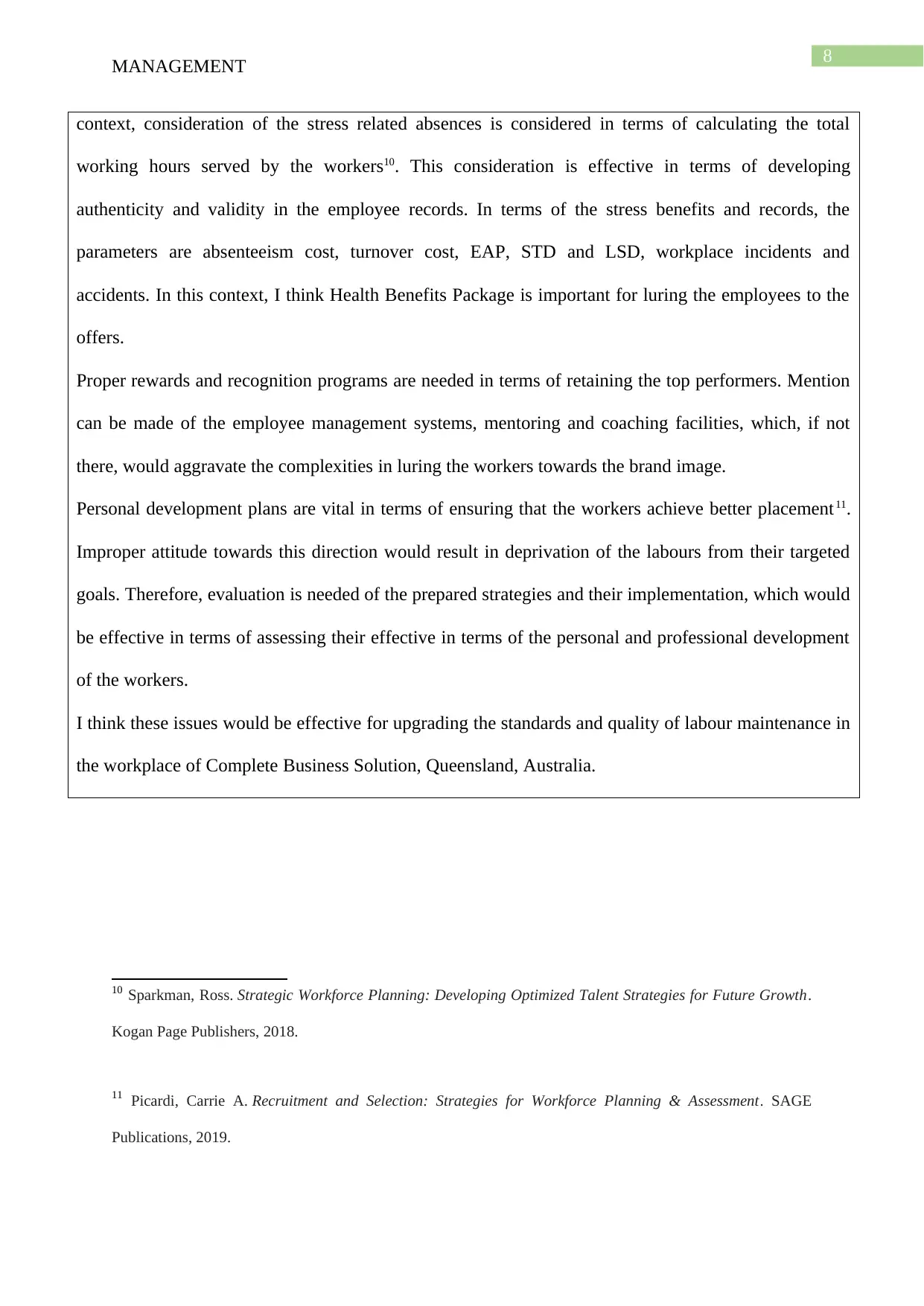
8
MANAGEMENT
context, consideration of the stress related absences is considered in terms of calculating the total
working hours served by the workers10. This consideration is effective in terms of developing
authenticity and validity in the employee records. In terms of the stress benefits and records, the
parameters are absenteeism cost, turnover cost, EAP, STD and LSD, workplace incidents and
accidents. In this context, I think Health Benefits Package is important for luring the employees to the
offers.
Proper rewards and recognition programs are needed in terms of retaining the top performers. Mention
can be made of the employee management systems, mentoring and coaching facilities, which, if not
there, would aggravate the complexities in luring the workers towards the brand image.
Personal development plans are vital in terms of ensuring that the workers achieve better placement11.
Improper attitude towards this direction would result in deprivation of the labours from their targeted
goals. Therefore, evaluation is needed of the prepared strategies and their implementation, which would
be effective in terms of assessing their effective in terms of the personal and professional development
of the workers.
I think these issues would be effective for upgrading the standards and quality of labour maintenance in
the workplace of Complete Business Solution, Queensland, Australia.
10 Sparkman, Ross. Strategic Workforce Planning: Developing Optimized Talent Strategies for Future Growth.
Kogan Page Publishers, 2018.
11 Picardi, Carrie A. Recruitment and Selection: Strategies for Workforce Planning & Assessment. SAGE
Publications, 2019.
MANAGEMENT
context, consideration of the stress related absences is considered in terms of calculating the total
working hours served by the workers10. This consideration is effective in terms of developing
authenticity and validity in the employee records. In terms of the stress benefits and records, the
parameters are absenteeism cost, turnover cost, EAP, STD and LSD, workplace incidents and
accidents. In this context, I think Health Benefits Package is important for luring the employees to the
offers.
Proper rewards and recognition programs are needed in terms of retaining the top performers. Mention
can be made of the employee management systems, mentoring and coaching facilities, which, if not
there, would aggravate the complexities in luring the workers towards the brand image.
Personal development plans are vital in terms of ensuring that the workers achieve better placement11.
Improper attitude towards this direction would result in deprivation of the labours from their targeted
goals. Therefore, evaluation is needed of the prepared strategies and their implementation, which would
be effective in terms of assessing their effective in terms of the personal and professional development
of the workers.
I think these issues would be effective for upgrading the standards and quality of labour maintenance in
the workplace of Complete Business Solution, Queensland, Australia.
10 Sparkman, Ross. Strategic Workforce Planning: Developing Optimized Talent Strategies for Future Growth.
Kogan Page Publishers, 2018.
11 Picardi, Carrie A. Recruitment and Selection: Strategies for Workforce Planning & Assessment. SAGE
Publications, 2019.
⊘ This is a preview!⊘
Do you want full access?
Subscribe today to unlock all pages.

Trusted by 1+ million students worldwide
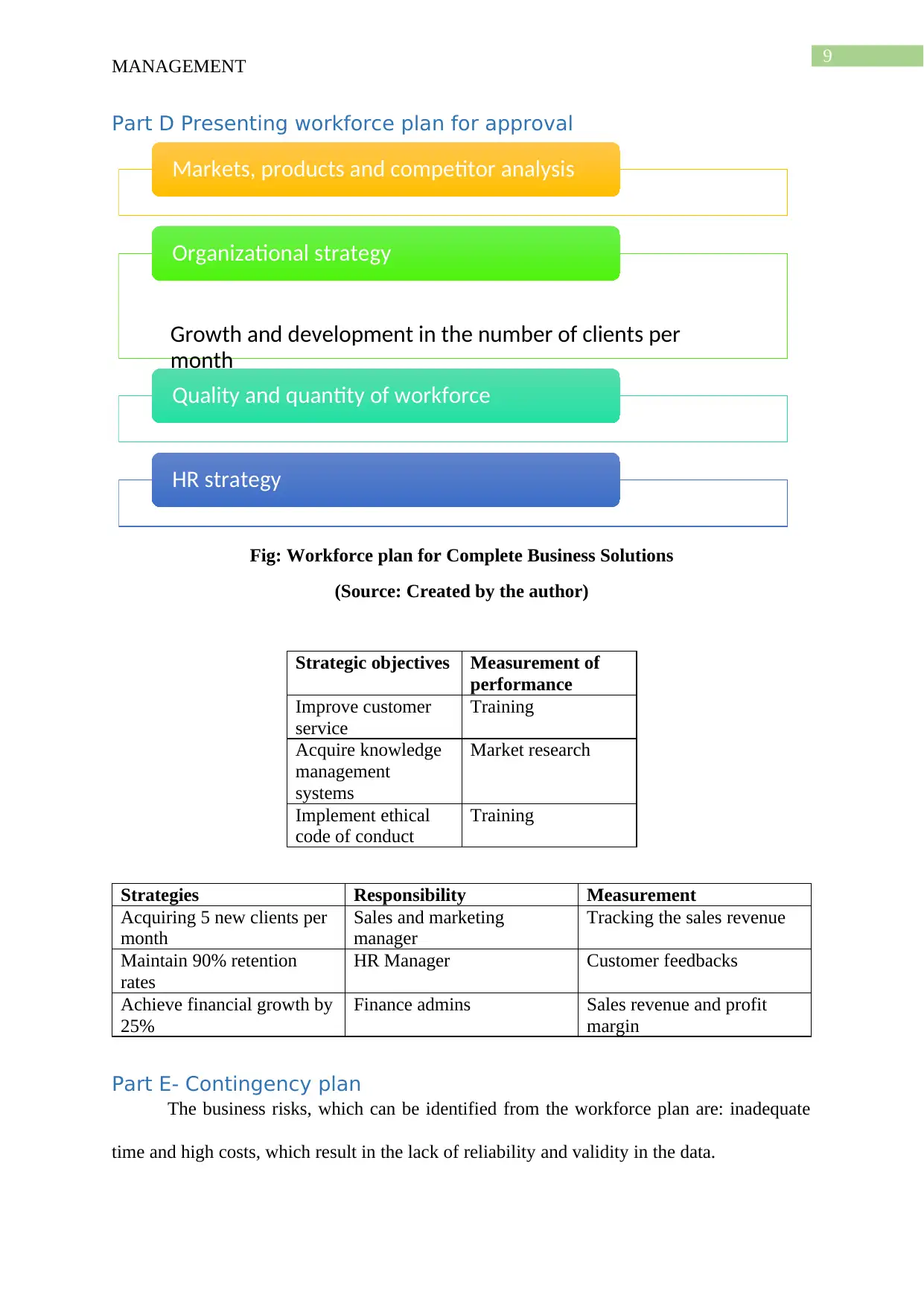
9
MANAGEMENT
Part D Presenting workforce plan for approval
Fig: Workforce plan for Complete Business Solutions
(Source: Created by the author)
Strategic objectives Measurement of
performance
Improve customer
service
Training
Acquire knowledge
management
systems
Market research
Implement ethical
code of conduct
Training
Strategies Responsibility Measurement
Acquiring 5 new clients per
month
Sales and marketing
manager
Tracking the sales revenue
Maintain 90% retention
rates
HR Manager Customer feedbacks
Achieve financial growth by
25%
Finance admins Sales revenue and profit
margin
Part E- Contingency plan
The business risks, which can be identified from the workforce plan are: inadequate
time and high costs, which result in the lack of reliability and validity in the data.
Markets, products and competitor analysis
Growth and development in the number of clients per
month
Organizational strategy
Quality and quantity of workforce
HR strategy
MANAGEMENT
Part D Presenting workforce plan for approval
Fig: Workforce plan for Complete Business Solutions
(Source: Created by the author)
Strategic objectives Measurement of
performance
Improve customer
service
Training
Acquire knowledge
management
systems
Market research
Implement ethical
code of conduct
Training
Strategies Responsibility Measurement
Acquiring 5 new clients per
month
Sales and marketing
manager
Tracking the sales revenue
Maintain 90% retention
rates
HR Manager Customer feedbacks
Achieve financial growth by
25%
Finance admins Sales revenue and profit
margin
Part E- Contingency plan
The business risks, which can be identified from the workforce plan are: inadequate
time and high costs, which result in the lack of reliability and validity in the data.
Markets, products and competitor analysis
Growth and development in the number of clients per
month
Organizational strategy
Quality and quantity of workforce
HR strategy
Paraphrase This Document
Need a fresh take? Get an instant paraphrase of this document with our AI Paraphraser
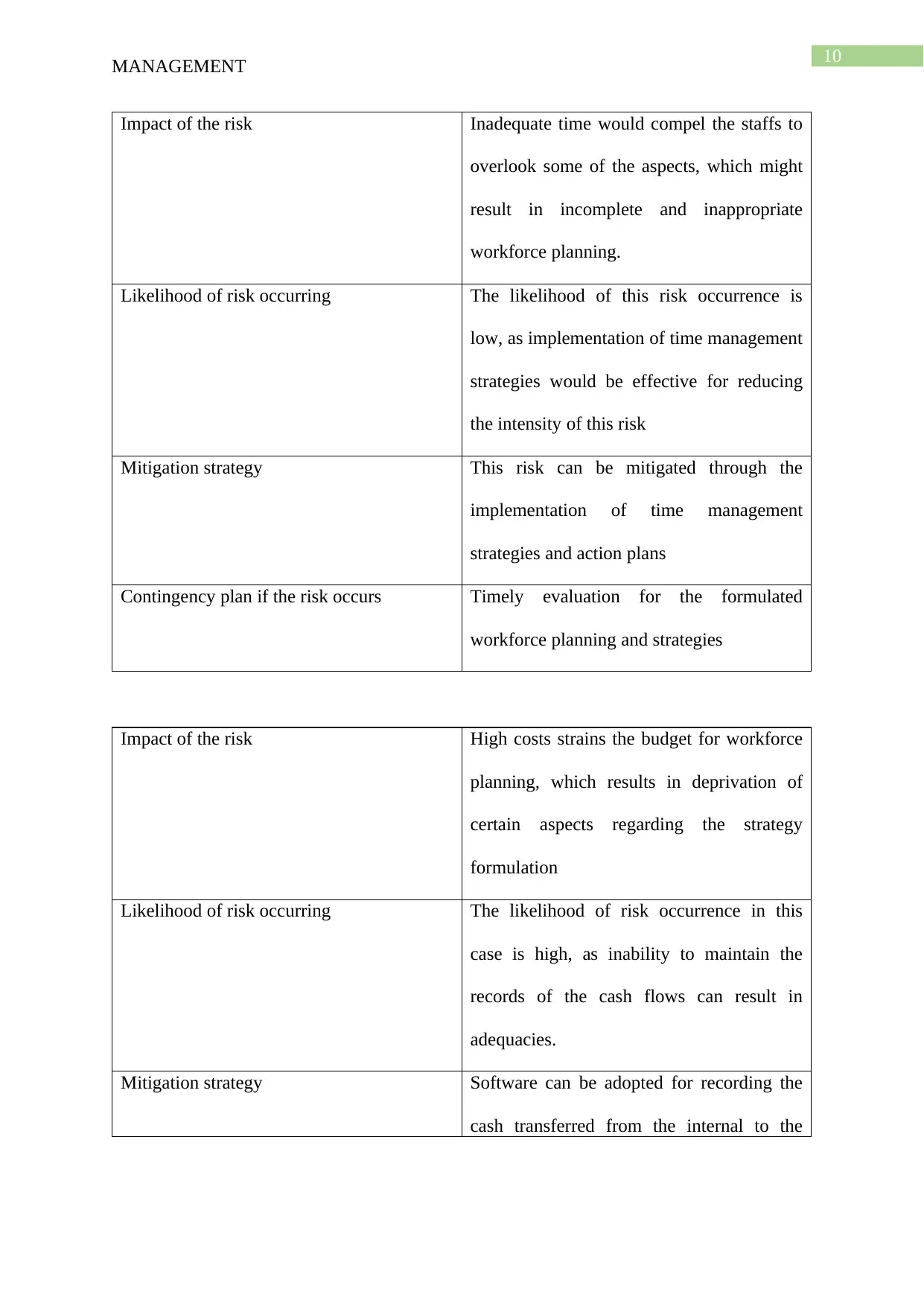
10
MANAGEMENT
Impact of the risk Inadequate time would compel the staffs to
overlook some of the aspects, which might
result in incomplete and inappropriate
workforce planning.
Likelihood of risk occurring The likelihood of this risk occurrence is
low, as implementation of time management
strategies would be effective for reducing
the intensity of this risk
Mitigation strategy This risk can be mitigated through the
implementation of time management
strategies and action plans
Contingency plan if the risk occurs Timely evaluation for the formulated
workforce planning and strategies
Impact of the risk High costs strains the budget for workforce
planning, which results in deprivation of
certain aspects regarding the strategy
formulation
Likelihood of risk occurring The likelihood of risk occurrence in this
case is high, as inability to maintain the
records of the cash flows can result in
adequacies.
Mitigation strategy Software can be adopted for recording the
cash transferred from the internal to the
MANAGEMENT
Impact of the risk Inadequate time would compel the staffs to
overlook some of the aspects, which might
result in incomplete and inappropriate
workforce planning.
Likelihood of risk occurring The likelihood of this risk occurrence is
low, as implementation of time management
strategies would be effective for reducing
the intensity of this risk
Mitigation strategy This risk can be mitigated through the
implementation of time management
strategies and action plans
Contingency plan if the risk occurs Timely evaluation for the formulated
workforce planning and strategies
Impact of the risk High costs strains the budget for workforce
planning, which results in deprivation of
certain aspects regarding the strategy
formulation
Likelihood of risk occurring The likelihood of risk occurrence in this
case is high, as inability to maintain the
records of the cash flows can result in
adequacies.
Mitigation strategy Software can be adopted for recording the
cash transferred from the internal to the
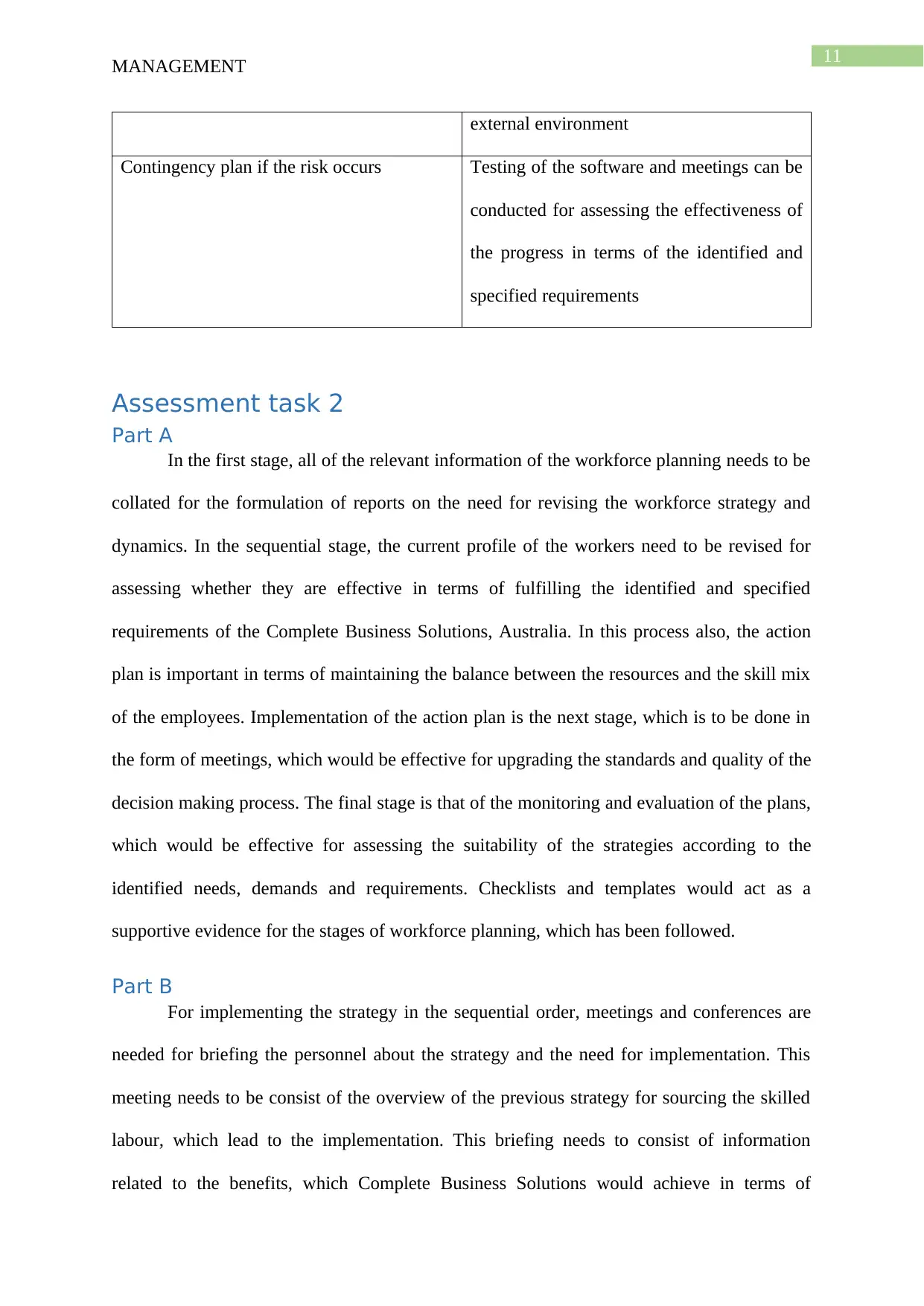
11
MANAGEMENT
external environment
Contingency plan if the risk occurs Testing of the software and meetings can be
conducted for assessing the effectiveness of
the progress in terms of the identified and
specified requirements
Assessment task 2
Part A
In the first stage, all of the relevant information of the workforce planning needs to be
collated for the formulation of reports on the need for revising the workforce strategy and
dynamics. In the sequential stage, the current profile of the workers need to be revised for
assessing whether they are effective in terms of fulfilling the identified and specified
requirements of the Complete Business Solutions, Australia. In this process also, the action
plan is important in terms of maintaining the balance between the resources and the skill mix
of the employees. Implementation of the action plan is the next stage, which is to be done in
the form of meetings, which would be effective for upgrading the standards and quality of the
decision making process. The final stage is that of the monitoring and evaluation of the plans,
which would be effective for assessing the suitability of the strategies according to the
identified needs, demands and requirements. Checklists and templates would act as a
supportive evidence for the stages of workforce planning, which has been followed.
Part B
For implementing the strategy in the sequential order, meetings and conferences are
needed for briefing the personnel about the strategy and the need for implementation. This
meeting needs to be consist of the overview of the previous strategy for sourcing the skilled
labour, which lead to the implementation. This briefing needs to consist of information
related to the benefits, which Complete Business Solutions would achieve in terms of
MANAGEMENT
external environment
Contingency plan if the risk occurs Testing of the software and meetings can be
conducted for assessing the effectiveness of
the progress in terms of the identified and
specified requirements
Assessment task 2
Part A
In the first stage, all of the relevant information of the workforce planning needs to be
collated for the formulation of reports on the need for revising the workforce strategy and
dynamics. In the sequential stage, the current profile of the workers need to be revised for
assessing whether they are effective in terms of fulfilling the identified and specified
requirements of the Complete Business Solutions, Australia. In this process also, the action
plan is important in terms of maintaining the balance between the resources and the skill mix
of the employees. Implementation of the action plan is the next stage, which is to be done in
the form of meetings, which would be effective for upgrading the standards and quality of the
decision making process. The final stage is that of the monitoring and evaluation of the plans,
which would be effective for assessing the suitability of the strategies according to the
identified needs, demands and requirements. Checklists and templates would act as a
supportive evidence for the stages of workforce planning, which has been followed.
Part B
For implementing the strategy in the sequential order, meetings and conferences are
needed for briefing the personnel about the strategy and the need for implementation. This
meeting needs to be consist of the overview of the previous strategy for sourcing the skilled
labour, which lead to the implementation. This briefing needs to consist of information
related to the benefits, which Complete Business Solutions would achieve in terms of
⊘ This is a preview!⊘
Do you want full access?
Subscribe today to unlock all pages.

Trusted by 1+ million students worldwide
1 out of 15
Related Documents
Your All-in-One AI-Powered Toolkit for Academic Success.
+13062052269
info@desklib.com
Available 24*7 on WhatsApp / Email
![[object Object]](/_next/static/media/star-bottom.7253800d.svg)
Unlock your academic potential
Copyright © 2020–2025 A2Z Services. All Rights Reserved. Developed and managed by ZUCOL.




